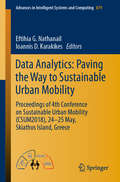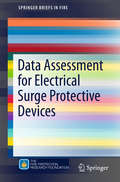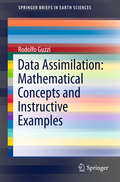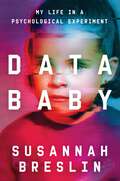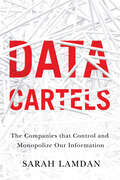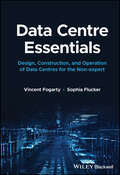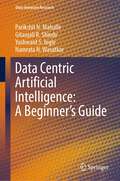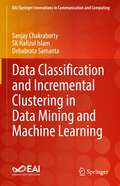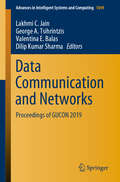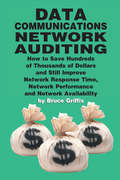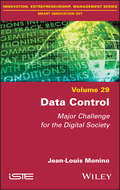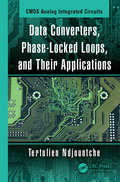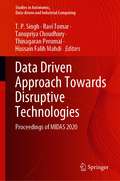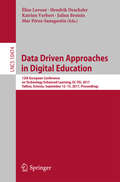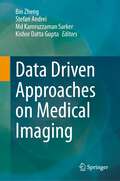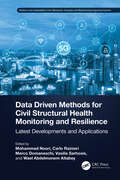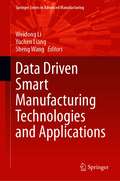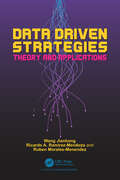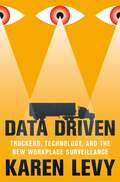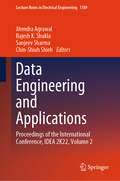- Table View
- List View
Data Analytics: Proceedings Of 4th Conference On Sustainable Urban Mobility (csum2018), 24 - 25 May, Skiathos Island, Greece (Advances In Intelligent Systems and Computing #879)
by Eftihia G. Nathanail Ioannis D. KarakikesThis book aims at showing how big data sources and data analytics can play an important role in sustainable mobility. It is especially intended to provide academicians, researchers, practitioners and decision makers with a snapshot of methods that can be effectively used to improve urban mobility. The different chapters, which report on contributions presented at the 4th Conference on Sustainable Urban Mobility, held on May 24-25, 2018, in Skiathos Island, Greece, cover different thematic areas, such as social networks and traveler behavior, applications of big data technologies in transportation and analytics, transport infrastructure and traffic management, transportation modeling, vehicle emissions and environmental impacts, public transport and demand responsive systems, intermodal interchanges, smart city logistics systems, data security and associated legal aspects. They show in particular how to apply big data in improving urban mobility, discuss important challenges in developing and implementing analytics methods and provide the reader with an up-to-date review of the most representative research on data management techniques for enabling sustainable urban mobility
Data Assessment for Electrical Surge Protective Devices (SpringerBriefs in Fire)
by Eddie Davis Nick Kooiman Kylash ViswanathanThis brief develops a data collection plan to assess loss related to electrical surges in homes, and explores the potential impact devices that prevent these surges could have in mitigating these losses. Key topics such as surge sources, surge effects and residential surge protection are clearly defined. Recent fire safety codes proposed a requirement that every dwelling unit be fitted with a surge protection device, as every year there is property damage to electrical and electronic equipment resulting from electrical surges. These proposals have not been implemented due to a lack of reliable data, which this brief seeks to change. The authors evaluate surge phenomena and their sources, surge protection methods, surge protection strategies and industry standards in order to present a data plan that can accurately assess loss related to electrical surges in homes.
Data Assimilation: Mathematical Concepts and Instructive Examples (SpringerBriefs in Earth Sciences)
by Rodolfo GuzziThis book endeavours to give a concise contribution to understanding the data assimilation and related methodologies. The mathematical concepts and related algorithms are fully presented, especially for those facing this theme for the first time. The first chapter gives a wide overview of the data assimilation steps starting from Gauss' first methods to the most recent as those developed under the Monte Carlo methods. The second chapter treats the representation of the physical system as an ontological basis of the problem. The third chapter deals with the classical Kalman filter, while the fourth chapter deals with the advanced methods based on recursive Bayesian Estimation. A special chapter, the fifth, deals with the possible applications, from the first Lorenz model, passing trough the biology and medicine up to planetary assimilation, mainly on Mars. This book serves both teachers and college students, and other interested parties providing the algorithms and formulas to manage the data assimilation everywhere a dynamic system is present.
Data Baby: My Life in a Psychological Experiment
by Susannah BreslinA Belletrist Book Pick for December 2023Lab Girl meets Brain on Fire in this provocative and poignant memoir delving into a woman's formative experiences as a veritable "lab rat" in a lifelong psychological study, and her pursuit to reclaim autonomy and her identity as a adult. What if your parents turn you into a human lab rat when you&’re a child? Will that change the story of your life? Will that change who you are? When Susannah Breslin is a toddler, her parents enroll her in an exclusive laboratory preschool at the University of California, Berkeley, where she becomes one of over a hundred children who are research subjects in an unprecedented thirty-year study of personality development that predicts who she and her cohort will grow up to be. Decades later, trapped in what she feels is an abusive marriage and battling breast cancer, she starts to wonder how growing up under a microscope shaped her identity and life choices. Already a successful journalist, she makes her own curious history the subject of her next investigation. From experiment rooms with one-way mirrors, to children&’s puzzles with no solutions, to condemned basement laboratories, her life-changing journey uncovers the long-buried secrets hidden behind the renowned study. The question at the gnarled heart of her quest: Did the study know her better than she knew herself? At once bravely honest and sharply witty, Data Baby is a compelling and provocative account of a woman&’s quest to find her true self, and an unblinking exploration of why we turn out as we do. Few people in all of history have been studied from such a young age and for as long as this author, but the message of her book is universal. In an era when so many of us are looking to technology to tell us who to be, it&’s up to us to discover who we actually are.
Data Borders: How Silicon Valley Is Building an Industry around Immigrants
by Melissa Villa-NicholasData Borders investigates entrenched and emerging borderland technology that ensnares all people in an intimate web of surveillance where data resides and defines citizenship. Detailing the new trend of biologically mapping undocumented people through biotechnologies, Melissa Villa-Nicholas shows how surreptitious monitoring of Latinx immigrants is the focus of and driving force behind Silicon Valley's growing industry within defense technology manufacturing. Villa-Nicholas reveals a murky network that gathers data on marginalized communities for purposes of exploitation and control that implicates law enforcement, border patrol, and ICE, but that also pulls in public workers and the general public, often without their knowledge or consent. Enriched by interviews of Latinx immigrants living in the borderlands who describe their daily use of technology and their caution around surveillance, this book argues that in order to move beyond a heavily surveilled state that dehumanizes both immigrants and citizens, we must first understand how our data is being collected, aggregated, correlated, and weaponized with artificial intelligence and then push for immigrant and citizen information privacy rights along the border and throughout the United States.
Data Breach at Equifax
by Suraj Srinivasan Quinn PitcherExamining the cause of and response to the 2017 data breach at Equifax that exposed the information of over 145 million consumers.
Data Cartels: The Companies That Control and Monopolize Our Information
by Sarah LamdanIn our digital world, data is power. Information hoarding businesses reign supreme, using intimidation, aggression, and force to maintain influence and control. Sarah Lamdan brings us into the unregulated underworld of these "data cartels", demonstrating how the entities mining, commodifying, and selling our data and informational resources perpetuate social inequalities and threaten the democratic sharing of knowledge. Just a few companies dominate most of our critical informational resources. Often self-identifying as "data analytics" or "business solutions" operations, they supply the digital lifeblood that flows through the circulatory system of the internet. With their control over data, they can prevent the free flow of information, masterfully exploiting outdated information and privacy laws and curating online information in a way that amplifies digital racism and targets marginalized communities. They can also distribute private information to predatory entities. Alarmingly, everything they're doing is perfectly legal. In this book, Lamdan contends that privatization and tech exceptionalism have prevented us from creating effective legal regulation. This in turn has allowed oversized information oligopolies to coalesce. In addition to specific legal and market-based solutions, Lamdan calls for treating information like a public good and creating digital infrastructure that supports our democratic ideals.
Data Centre Essentials: Design, Construction, and Operation of Data Centres for the Non-expert
by Vincent Fogarty Sophia FluckerData Centre Essentials Understand the design, construction and operation of data centres with this easy-to-use reference Data centres are spaces where computer systems, physical network technology and associated components are housed, operated and monitored, and any industry or business that employs computer systems or networked systems at any scale will interact with data centres. Data centres are complex and expensive to build and operate, and successful project delivery requires a wide range of specialised knowledge and skills. This accessible reference lays out the requirements for creating these essential facilities. Data Centre Essentials is a comprehensive survey of the essential principles of data centre design, construction and operation. It is designed to provide those involved in a data centre project or providing professional service deliverables to the data centre industry but do not have a technical background or deep sector experience with the understanding required to participate in such projects. The non-technical language and thorough engagement with key considerations make it ideal for anyone looking to understand one of the pillars of a digital society. Data Centre Essentials readers will also find: An authorial team with decades of combined experience in engineering and construction consultancy Detailed information about every stage in the process, including securing investment and the building process Working lexicon of key data centre terminology Data Centre Essentials is a must-own for contractors, engineers and construction project managers involved in data centre projects and will be invaluable for professionals such as lawyers, financial and insurance advisors, surveyors, engineers and architects who do not necessarily have deep domain experience but find themselves involved in or are interested in engaging in, data centre projects.
Data Centric Artificial Intelligence: A Beginner’s Guide (Data-Intensive Research)
by Parikshit N. Mahalle Gitanjali R. Shinde Yashwant S. Ingle Namrata N. WasatkarThis book discusses the best research roadmaps, strategies, and challenges in data-centric approach of artificial intelligence (AI) in various domains. It presents comparative studies of model-centric and data-centric AI. It also highlights different phases in data-centric approach and data-centric principles. The book presents prominent use cases of data-centric AI. It serves as a reference guide for researchers and practitioners in academia and industry.
Data Classification and Incremental Clustering in Data Mining and Machine Learning (EAI/Springer Innovations in Communication and Computing)
by Sk Hafizul Islam Debabrata Samanta Sanjay ChakrabortyThis book is a comprehensive, hands-on guide to the basics of data mining and machine learning with a special emphasis on supervised and unsupervised learning methods. The book lays stress on the new ways of thinking needed to master in machine learning based on the Python, R, and Java programming platforms. This book first provides an understanding of data mining, machine learning and their applications, giving special attention to classification and clustering techniques. The authors offer a discussion on data mining and machine learning techniques with case studies and examples. The book also describes the hands-on coding examples of some well-known supervised and unsupervised learning techniques using three different and popular coding platforms: R, Python, and Java. This book explains some of the most popular classification techniques (K-NN, Naïve Bayes, Decision tree, Random forest, Support vector machine etc,) along with the basic description of artificial neural network and deep neural network. The book is useful for professionals, students studying data mining and machine learning, and researchers in supervised and unsupervised learning techniques.
Data Communication and Networks: Proceedings of GUCON 2019 (Advances in Intelligent Systems and Computing #1049)
by Lakhmi C. Jain George A. Tsihrintzis Valentina E. Balas Dilip Kumar SharmaThis book gathers selected high-quality papers presented at the International Conference on Computing, Power and Communication Technologies 2019 (GUCON 2019), organized by Galgotias University, India, in September 2019. The content is divided into three sections – data mining and big data analysis, communication technologies, and cloud computing and computer networks. In-depth discussions of various issues within these broad areas provide an intriguing and insightful reference guide for researchers, engineers and students alike.
Data Communications Network Auditing
by Bruce GriffisThis book contains product specific information based on Cisco router command line interface, and IBM's Net view. It is designed to help us understand the "parts and pieces" of communications and determine how components fit together, and what they look like on your bill.
Data Control: Major Challenge for the Digital Society
by Jean-Louis MoninoBusinesses are becoming increasingly aware of the importance of data and information. As such, they are eager to develop ways to "manage" them, to enrich them and take advantage of them. Indeed, the recent explosion of a phenomenal amount of data, and the need to analyze it, brings to the forefront the well-known hierarchical model: "Data, Information, Knowledge". "Data"– this new intangible manna – is produced in real time. It arrives in a continuous stream and comes from a multitude of sources that are generally heterogeneous. This accumulation of data of all kinds is generating new activities designed to analyze these huge amounts of information. It is therefore necessary to adapt and try new approaches, methods, new knowledge and new ways of working. This leads to new properties and new issues as a logical reference must be created and implemented. At the company level, this mass of data is difficult to manage; interpreting it is the predominant challenge.
Data Converters, Phase-Locked Loops, and Their Applications
by Tertulien NdjountcheWith a focus on designing and verifying CMOS analog integrated circuits, the book reviews design techniques for mixed-signal building blocks, such as Nyquist and oversampling data converters, and circuits for signal generation, synthesis, and recovery. The text details all aspects, from specifications to the final circuit, of the design of digital-to-analog converters, analog-to-digital converters, phase-locked loops, delay-locked loops, high-speed input/output link transceivers, and class D amplifiers. Special emphasis is put on calibration methods that can be used to compensate circuit errors due to device mismatches and semiconductor process variations. Gives an overview of data converters, phase- and delay-locked loop architectures,highlighting basic operation and design trade-offs. Focus on circuit analysis methods useful to meet requirements for a high-speed and power-efficient operation. Outlines design challenges of analog integrated circuits using state-of-the-art CMOS processes. Presents design methodologies to optimize circuit performance on both transistor and architectural levels. Includes open-ended circuit design case studies.
Data Driven Approach Towards Disruptive Technologies: Proceedings of MIDAS 2020 (Studies in Autonomic, Data-driven and Industrial Computing)
by T. P. Singh Thinagaran Perumal Tanupriya Choudhury Ravi Tomar Hussain Falih MahdiThis book is a compilation of peer-reviewed papers presented at the International Conference on Machine Intelligence and Data Science Applications, organized by the School of Computer Science, University of Petroleum & Energy Studies, Dehradun, India, during 4–5 September 2020. The book addresses the algorithmic aspect of machine intelligence which includes the framework and optimization of various states of algorithms. Variety of papers related to wide applications in various fields like data-driven industrial IoT, bioinformatics, network and security, autonomous computing and various other aligned areas. The book concludes with interdisciplinary applications like legal, health care, smart society, cyber-physical system and smart agriculture. All papers have been carefully reviewed. The book is of interest to computer science engineers, lecturers/researchers in machine intelligence discipline and engineering graduates.
Data Driven Approaches in Digital Education: 12th European Conference on Technology Enhanced Learning, EC-TEL 2017, Tallinn, Estonia, September 12–15, 2017, Proceedings (Lecture Notes in Computer Science #10474)
by Katrien Verbert Hendrik Drachsler Élise Lavoué Mar Pérez-Sanagustín Julien BroisinThis book constitutes the proceedings of the 12th European Conference on Technology Enhanced Learning, EC-TEL 2017, held in Tallinn, Estonia, in September 2017. The 24 full papers, 23 short papers, 6 demo papers, and 22 poster papers presented in this volume were carefully reviewed and selected from 141 submissions. The theme for the 12th EC-TEL conference on Data Driven Approaches in Digital Education' aims to explore the multidisciplinary approaches that eectively illustrate how data-driven education combined with digital education systems can look like and what are the empirical evidences for the use of datadriven tools in educational practices.
Data Driven Approaches on Medical Imaging
by Bin Zheng Stefan Andrei Md Kamruzzaman Sarker Kishor Datta GuptaThis book deals with the recent advancements in computer vision techniques such as active learning, few-shot learning, zero shot learning, explainable and interpretable ML, online learning, AutoML etc. and their applications in medical domain. Moreover, the key challenges which affect the design, development, and performance of medical imaging systems are addressed. In addition, the state-of-the-art medical imaging methodologies for efficient, interpretable, explainable, and practical implementation of computer imaging techniques are discussed. At present, there are no textbook resources that address the medical imaging technologies. There are ongoing and novel research outcomes which would be useful for the development of novel medical imaging technologies/processes/equipment which can improve the current state of the art.The book particularly focuses on the use of data driven new technologies on medical imaging vision such as Active learning, Online learning, few shot learning, AutoML, segmentation etc.
Data Driven Decision Making using Analytics (Computational Intelligence Techniques)
by Parul GandhiThis book aims to explain Data Analytics towards decision making in terms of models and algorithms, theoretical concepts, applications, experiments in relevant domains or focused on specific issues. It explores the concepts of database technology, machine learning, knowledge-based system, high performance computing, information retrieval, finding patterns hidden in large datasets and data visualization. Also, it presents various paradigms including pattern mining, clustering, classification, and data analysis. Overall aim is to provide technical solutions in the field of data analytics and data mining. Features: Covers descriptive statistics with respect to predictive analytics and business analytics. Discusses different data analytics platforms for real-time applications. Explain SMART business models. Includes algorithms in data sciences alongwith automated methods and models. Explores varied challenges encountered by researchers and businesses in the realm of real-time analytics. This book aims at researchers and graduate students in data analytics, data sciences, data mining, and signal processing.
Data Driven Methods for Civil Structural Health Monitoring and Resilience: Latest Developments and Applications (Resilience and Sustainability in Civil, Mechanical, Aerospace and Manufacturing Engineering Systems)
by Carlo Rainieri Mohammad Noori Vasilis Sarhosis Marco Domaneschi Wael Abdelmonem AltabeyData Driven Methods for Civil Structural Health Monitoring and Resilience: Latest Developments and Applications provides a comprehensive overview of data-driven methods for structural health monitoring (SHM) and resilience of civil engineering structures, mostly based on artificial intelligence or other advanced data science techniques. This allows existing structures to be turned into smart structures, thereby allowing them to provide intelligible information about their state of health and performance on a continuous, relatively real-time basis. Artificial-intelligence-based methodologies are becoming increasingly more attractive for civil engineering and SHM applications; machine learning and deep learning methods can be applied and further developed to transform the available data into valuable information for engineers and decision makers.
Data Driven Smart Manufacturing Technologies and Applications (Springer Series in Advanced Manufacturing)
by Weidong Li Sheng Wang Yuchen LiangThis book reports innovative deep learning and big data analytics technologies for smart manufacturing applications. In this book, theoretical foundations, as well as the state-of-the-art and practical implementations for the relevant technologies, are covered. This book details the relevant applied research conducted by the authors in some important manufacturing applications, including intelligent prognosis on manufacturing processes, sustainable manufacturing and human-robot cooperation. Industrial case studies included in this book illustrate the design details of the algorithms and methodologies for the applications, in a bid to provide useful references to readers. Smart manufacturing aims to take advantage of advanced information and artificial intelligent technologies to enable flexibility in physical manufacturing processes to address increasingly dynamic markets. In recent years, the development of innovative deep learning and big data analytics algorithms is dramatic. Meanwhile, the algorithms and technologies have been widely applied to facilitate various manufacturing applications. It is essential to make a timely update on this subject considering its importance and rapid progress. This book offers a valuable resource for researchers in the smart manufacturing communities, as well as practicing engineers and decision makers in industry and all those interested in smart manufacturing and Industry 4.0.
Data Driven Strategies: Theory and Applications
by Ricardo A. Ramirez-Mendoza Ruben Morales-Menendez Wang JianhongA key challenge in science and engineering is to provide a quantitative description of the systems under investigation, leveraging the noisy data collected. Such a description may be a complete mathematical model or a mechanism to return controllers corresponding to new, unseen inputs. Recent advances in the theories are described in detail, along with their applications in engineering. The book aims to develop model-free system analysis and control strategies, i.e., data-driven control from theoretical analysis and engineering applications based only on measured data. The study aims to develop system identification, and combination in advanced control theory, i.e., data-driven control strategy as system and controller are generated from measured data directly. The book reviews the development of system identification and its combination in advanced control theory, i.e., data-driven control strategy, as they all depend on measured data. Firstly, data-driven identification is developed for the closed-loop, nonlinear system and model validation, i.e., obtaining model descriptions from measured data. Secondly, the data-driven idea is combined with some control strategies to be considered data-driven control strategies, such as data-driven model predictive control, data-driven iterative tuning control, and data-driven subspace predictive control. Thirdly data-driven identification and data-driven control strategies are applied to interested engineering. In this context, the book provides algorithms to perform state estimation of dynamical systems from noisy data and some convex optimization algorithms through identification and control problems.
Data Driven: Truckers, Technology, and the New Workplace Surveillance
by Karen LevyA behind-the-scenes look at how digital surveillance is affecting the trucking way of lifeLong-haul truckers are the backbone of the American economy, transporting goods under grueling conditions and immense economic pressure. Truckers have long valued the day-to-day independence of their work, sharing a strong occupational identity rooted in a tradition of autonomy. Yet these workers increasingly find themselves under many watchful eyes. Data Driven examines how digital surveillance is upending life and work on the open road, and raises crucial questions about the role of data collection in broader systems of social control.Karen Levy takes readers inside a world few ever see, painting a bracing portrait of one of the last great American frontiers. Federal regulations now require truckers to buy and install digital monitors that capture data about their locations and behaviors. Intended to address the pervasive problem of trucker fatigue by regulating the number of hours driven each day, these devices support additional surveillance by trucking firms and other companies. Traveling from industry trade shows to law offices and truck-stop bars, Levy reveals how these invasive technologies are reconfiguring industry relationships and providing new tools for managerial and legal control—and how truckers are challenging and resisting them.Data Driven contributes to an emerging conversation about how technology affects our work, institutions, and personal lives, and helps to guide our thinking about how to protect public interests and safeguard human dignity in the digital age.
Data Economy in the Digital Age (Data-Intensive Research)
by Samiksha Shukla Kapil Tiwari Shahid Bashir Kritica BishtThe book is a comprehensive guide that explores the concept of data economy and its implications in today's world. The book discusses the principles and components of the ecosystem, the challenges and opportunities presented by data monetization, and the potential risks related to data privacy. Real-life examples and case studies are included to understand the concepts better. The book is suitable for individuals in data science, economics, business, and technology and for students, academics, and policymakers. It is an excellent read for anyone interested in the data economy.
Data Engineering and Applications: Proceedings of the International Conference, IDEA 2K22, Volume 1 (Lecture Notes in Electrical Engineering #1146)
by Jitendra Agrawal Sanjeev Sharma Rajesh K. Shukla Chin-Shiuh ShiehThis book comprises select proceedings from the 4th International Conference on Data, Engineering, and Applications (IDEA 2022). The contents discuss novel contributions and latest developments in the domains of data structures and data management algorithms, information retrieval and information integration, social data analytics, IoT and data intelligence, Industry 4.0 and digital manufacturing, data fusion, natural language processing, geolocation handling, image, video and signal processing, ICT applications and e-governance, among others. This book is of interest to researchers in academia and industry working in big data, data mining, machine learning, data science, and their associated learning systems and applications.
Data Engineering and Applications: Proceedings of the International Conference, IDEA 2K22, Volume 2 (Lecture Notes in Electrical Engineering #1189)
by Jitendra Agrawal Sanjeev Sharma Rajesh K. Shukla Chin-Shiuh ShiehThis book comprises select proceedings from the 4th International Conference on Data, Engineering, and Applications (IDEA 2022). The contents discuss novel contributions and latest developments in the domains of data structures and data management algorithms, information retrieval and information integration, social data analytics, IoT and data intelligence, Industry 4.0 and digital manufacturing, data fusion, natural language processing, geolocation handling, image, video and signal processing, ICT applications and e-governance, among others. This book is of interest to researchers in academia and industry working in big data, data mining, machine learning, data science, and their associated learning systems and applications.
